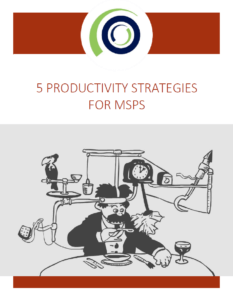OnPage Trend Report: 5 MSP Productivity Strategies

Ask any MSP and they will tell you that maintaining and solving IT issues for their clients lends itself to busyness. However, studies show that being busy doesn’t always mean being productive. In fact, a recent study found that the U.S. economy suffers a nearly $1.3 trillion productivity loss each year.
To determine where MSPs might adjust their work habits to be more productive, we sought out the advice of our MSP customers and distilled their recommendations on how to be more productive based on the tools they use.
MSP Productivity Tip 1 – INCREASE PRODUCTIVITY BY CONSOLIDATING COMMUNICATIONS
Typically MSPs communicate over email, getting 100 or more emails a day, without a clue as to how to handle this volume. Sending and receiving emails without getting the whole picture not only causes confusion but wastes time that could be used to tackle the problem at hand. MSPs cc each other excessively just to keep everyone in the loop, and use a host of applications like Project Management, email marketing CRM, service automation and so on . Even these are mostly cloud based, with no integration, so every one of these systems needs to be checked separately if MSPs want the whole picture.
What MSPs are looking for is an overall improvement in their communication with each other, vendors, and clients so they can focus on their work instead of emails. They would love to get answers from a system, application or from each other regardless of location – in the car, office or at home. Slack does a great job of bringing communication to one platform. If you ever need to bring visibility to an issue in a crowded Slack thread, Slack makes it possible to integrate with alert management tools by which a Slack message gets converted to a critical alert. In essence Slack creates a unified platform for company-wide communication and replaces internal emails almost completely.
MSP Productivity Tip 2 – INCREASE PRODUCTIVITY BY SCHEDULING RECURRING TICKETS
If you automate the process of capturing and dispatching tickets, the productivity of your service team will increase. But what about recurring tasks? With ConnectWise you can automate regular tasks that deal with documents, finance, configurations and more. Additionally, you can schedule the right resources to make sure these important client maintenance tasks are completed on time.
You can also create a standard service template for one-off tickets that you know will occur frequently such as workstation and server installs. With these templates in place, tickets can be created and entered into the system quickly, ensuring you capitalize on important revenue opportunities.
According to a ConnectWise blog :
“Bid adieu! To ticketing déjà-vu. When a familiar request comes in from a client that you’ve already handled for a different one, just copy the entire previous ticket (tasks, configurations, documents, and all), and save yourself the headache of recreating the wheel, or in this case, the ticket.”
To read 3 more productivity tips, download our white paper:






